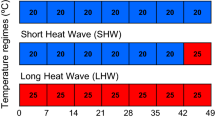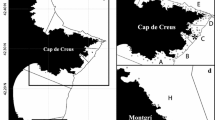Abstract
In fresh waters, non-native invertebrate species preferentially spread via navigation waterways, where they often dominate assemblages. Littoral habitats in navigation waterways are regularly exposed to ship-induced waves. We conducted experiments to test the effects of artificial wave exposure on the relative performance of wide-spread native and non-native species. We compared physiological and behavioural response variables (i.e. growth rate, glycogen content, feeding and swimming activity) of two amphipods (native Gammarus roeselii and non-native Dikerogammarus villosus) and two gastropods (native Bithynia tentaculata and non-native Physella acuta) subject to wave and control (i.e. no wave) treatment flumes across a 6-week period. Growth, and in part glycogen content (as a measure of energy storage), were significantly reduced after exposure to waves in native invertebrates, but not in non-native invertebrates. The reduction in growth may be associated with the disturbance effects of waves, such as the higher swimming activity of G. roeselii and lower food uptake of B. tentaculata. In comparison, the effective hiding behaviour observed for D. villosus and good swimming ability of P. acuta, were identified as important traits facilitating the successful colonisation of the harsh habitat conditions of littoral waterways. Our study demonstrates that artificial wave regimes may contribute significant selective pressure, thus explaining the observed dominance of non-native species in navigational waterways. The success of non-native species under the harsh hydraulic habitat conditions of these socio-economically driven ecosystems may consequently be traced directly to behavioural and/or physiological traits.



Similar content being viewed by others
References
Alford RA, Brown GP, Schwarzkopf L, Phillips BL, Shine R (2009) Comparisons through time and space suggest rapid evolution of dispersal behaviour in an invasive species. Wildlife Res 36:23–28. doi:10.1071/WR08021
bij de Vaate A, Jazdzewski K, Ketelaars HAM, Gollasch S, van der Velde G (2002) Geographical patterns in range extension of Ponto-Caspian macroinvertebrate species in Europe. Can J Fish Aquat Sci 59:1159–1174. doi:10.1139/F02-098
Bishop MJ (2008) Displacement of epifauna from seagrass blades by boat wake. J Exp Mar Biol Ecol 354:111–118. doi:10.1016/j.jembe.2007.10.013
Borcherding J, Sturm W (2002) The seasonal succession of macroinvertebrates, in particular the zebra mussel (Dreissena polymorpha), in the River Rhine and two neighbouring gravel-pit lakes monitored using artificial substrates. Int Rev Hydrobiol 87:165–181
Brendelberger H, Jurgens S (1993) Suspension feeding in Bithynia tentaculata (Prosobranchia, Bithyniidae), as affected by body size, food and temperature. Oecologia 94:36–42
Bruijs MCM, Kelleher B, van der Velde G, de Vaate AB (2001) Oxygen consumption, temperature and salinity tolerance of the invasive amphipod Dikerogammarus villosus: indicators of further dispersal via ballast water transport. Arch Hydrobiol 152:633–646
Buckup L, Dutra BK, Ribarcki FP, Fernandes FA, Noro CK, Oliveira GT, Vinagre AS (2008) Seasonal variations in the biochemical composition of the crayfish Parastacus defossus (Crustacea, Decapoda) in its natural environment. Comp Biochem Phys A 149:59–67. doi:10.1016/j.cbpa.2007.10.008
Byers JE (2002) Impact of non-indigenous species on natives enhanced by anthropogenic alteration of selection regimes. Oikos 97:449–458
Cope NJ, Winterbourn MJ (2004) Competitive interactions between two successful molluscan invaders of freshwaters: an experimental study. Aquat Ecol 38:83–91
Correa C, Gross MR (2008) Chinook salmon invade southern South America. Biol Invas 10:615–639. doi:10.1007/s10530-007-9157-2
Cremer S, Ugelvig LV, Drijfhout FP, Schlick-Steiner BC, Steiner FM, Seifert B, Hughes DP et al (2008) The evolution of invasiveness in garden ants. PLoS ONE 3:e3838. doi:10.1371/journal.pone.0003838
Dick JTA (2008) Role of behaviour in biological invasions and species distributions; lessons from interactions between the invasive Gammarus pulex and the native G. duebeni (Crustacea: Amphipoda). Contrib Zool 77:91–98
Dick JTA, Platvoet D (2000) Invading predatory crustacean Dikerogammarus villosus eliminates both native and exotic species. Proc R Soc B-Biol Sci 267:977–983
Dick JTA, Elwood RW, Montgomery WI (1995) The behavioural basis of a species replacement–Differential aggression and predation between the introduced Gammarus pulex and the native G. duebeni celticus (Amphipoda). Behav Ecol Sociobiol 37:393–398
Dillon RT, Wethington AR, Rhett JM, Smith TP (2002) Populations of the European freshwater pulmonate Physa acuta are not reproductively isolated from American Physa heterostropha or Physa integra. Invertebr Biol 121:226–234
Gabel F, Stoll S, Fischer P, Pusch M, Garcia XF (2011) Waves affect predator-prey interactions between fish and benthic invertebrates. Oecologia 165:101–109. doi:10.1007/s00442-010-1841-8
Gabel F, Garcia XF, Brauns M, Sukhodolov A, Leszinski M, Pusch MT (2008) Resistance to ship-induced waves of benthic invertebrates in various littoral habitats. Freshw Biol 53:1567–1578. doi:10.1111/j.1365-2427.2008.01991.x
Gergs R, Rothhaupt KO (2008) Feeding rates, assimilation efficiencies and growth of two amphipod species on biodeposited material from zebra mussels. Freshwater Biol 53:2494–2503. doi:10.1111/j.1365-2427.2008.02077.x
Grabowski M, Bacela K, Konopacka A (2007) How to be an invasive gammarid (Amphipoda: Gammaroidea)-comparison of life history traits. Hydrobiologia 590:75–84. doi:10.1007/s10750-007-0759-6
Henery ML, Bowman G, Mraz P, Treier UA, Gex-Fabry E, Schaffner U, Muller-Scharer H (2010) Evidence for a combination of pre-adapted traits and rapid adaptive change in the invasive plant Centaurea stoebe. J Ecol 98:800–813. doi:10.1111/j.1365-2745.2010.01672.x
Höckelmann C, Pusch M (2000) The respiration and filter-feeding rates of the snail Viviparus viviparus (Gastropoda) under simulated stream conditions. Arch Hydrobiol 49:553–568
Holdich DM, Pöckl M (2007) Invasive crustaceans in European inland waters. In: Gherardi F (ed) Biological invaders in inland waters: profiles, distribution, and threats. Springer, Berlin, pp 29–75
Hunter RD (1975) Growth, fecundity, and bioenergetics in 3 populations of Lymnaea-Palustris in Upstate New-York. Ecology 56:50–63
Kinzelbach R (1995) Neozoans in European waters—exemplifying the worldwide process of invasion and species mixing. Experientia 51:526–538
Krisp H, Maier G (2005) Consumption of macroinvertebrates by invasive and native gammarids: a comparison. J Limnol 64:55–59
Larson ER, Magoulick D, Turner C, Layock KH (2009) Disturbance and species displacement: different tolerances to stream drying and desiccation in a native and an invasive crayfish. Freshw Biol 54:1899–1908. doi:10.1111/j.1365-2427.2009.02243.x
Leuven RSEW, van der Velde G, Baijens I, Snijders J, van der Zwart C, Lenders HJR, de Vaate AB (2009) The river Rhine: a global highway for dispersal of aquatic invasive species. Biol Invas 11:1989–2008. doi:10.1007/s10530-009-9491-7
Mills EL, Leach JH, Carlton JT, Secor CL (1993) Exotic species in the Great-Lakes—a history of biotic crises and anthropogenic introductions. J Great Lakes Res 19:1–54
Miranda NAF, Perissinotto R, Appleton CC (2010) Salinity and temperature tolerance of the invasive freshwater gastropod Tarebia granifera. S Afr J 106:55–61. doi:10.4102/sajs.v106i3/4.156
Moog O (ed) (2002) Fauna Aquatica Austriaca—a comprehensive species inventory of Austrian aquatic organisms with ecological notes. Wasserwirtschaftskataster. Bundesministerium für Land- und Forstwirtschaft, Umwelt und Wasserwirtschaft, Vienna
Mörtl M, Rothhaupt KO (2003) Effects of adult Dreissena polymorpha on settling juveniles and associated macroinvertebrates. Int Rev Hydrobiol 88:561–569. doi:10.1002/iroh.200310640
Oscoz Pedro, Tomás P, Durán C (2010) Review and new records of non-indigenous freshwater invertebrates in the Ebro River basin (Northeast Spain). Aquat Invas 5:263–284. doi:10.3391/ai.2010.5.3.04
Pennuto C, Keppler D (2008) Short-term predator avoidance behavior by invasive and native amphipods in the Great Lakes. Aquat Ecol 42:629–641. doi:10.1007/s10452-007-9139-6
Platvoet D, Dick JTA, MacNeil C, van Riel MC, van der Velde G (2009a) Invader-invader interactions in relation to environmental heterogeneity leads to zonation of two invasive amphipods, Dikerogammarus villosus (Sowinsky) and Gammarus tigrinus Sexton: amphipod pilot species project (AMPIS) report 6. Biol Invas 11:2085–2093. doi:10.1007/s10530-009-9488-2
Platvoet D, van der Velde G, Dick JTA, Li SQ (2009b) Flexible omnivory in Dikerogammarus villosus (Sowinsky, 1894) (Amphipoda)—Amphipod Pilot Species Project (AMPIS) Report 5. Crustaceana 82:703–720. doi:10.1163/156854009X423201
Pöckl M (2007) Strategies of a successful new invader in European fresh waters: fecundity and reproductive potential of the Ponto-Caspian amphipod Dikerogammarus villosus in the Austrian Danube, compared with the indigenous Gammarus fossarum and G.roeselii. Freshw Biol 52:50–63. doi:10.1111/j.1365-2427.2006.01671.x
Pöckl M (2009) Success of the invasive Ponto-Caspian amphipod Dikerogammarus villosus by life history traits and reproductive capacity. Biol Invas 11:2021–2041. doi:10.1007/s10530-009-9485-5
Roe JH, Dailey RE (1966) Determination of glycogen with anthrone reagent. Anal Biochem 15:245–250
Sala OE, Chapin FS, Armesto JJ, Berlow E, Bloomfield J, Dirzo R, Huber-Sanwald E, Huenneke LF, Jackson RB, Kinzig A, Leemans R, Lodge DM, Mooney HA, Oesterheld M, Poff NL, Sykes MT, Walker BH, Walker M, Wall DH (2000) Biodiversity—global biodiversity scenarios for the year 2100. Science 287:1770–1774
Scheifhacken N (2006) Life at turbulent sites—Benthic communities in lake littorals interacting with abiotic and biotic constraints. Dissertation, University of Constance
Schlaepfer DR, Glättli M, Fischer M, Van Kleunen M (2009) A multi-species experiment in their native range indicates pre-adaptation of invasive alien plant species. New Phytol 185:1087–1099. doi:10.1111/j.1469-8137.2009.03114.x
Strayer DL (2010) Alien species in fresh waters: ecological effects, interactions with other stressors, and prospects for the future. Freshw Biol 55:152–174. doi:10.1111/j.1365-2427.2009.02380.x
Tashiro JS (1982) Grazing in Bithynia-Tentaculata - age-specific bioenergetic patterns in reproductive partitioning of ingested carbon and nitrogen. Am Midl Nat 107:133–150
Tashiro JS, Colman SD (1982) Filter-feeding in the fresh-water Prosobranch snail Bithynia-Tentaculata - bioenergetic partitioning of ingested carbon and nitrogen. Am Midl Nat 107:114–132
Van der Velde G, Leuven RSEW, Platvoet D, Bacela K, Huijbregts MAJ, Hendriks HWM, Kruijt D (2009) Environmental and morphological factors influencing predatory behaviour by invasive non-indigenous gammaridean species. Biol Invas 11:2043–2054. doi:10.1007/s10530-009-9500-x
van Kleunen M, Dawson W, Schlaepfer D, Jeschke JM, Fischer M (2010) Are invaders different? A conceptual framework of comparative approaches for assessing determinants of invasiveness. Ecol Lett 13(8):947–958. doi:10.1111/j.1461-0248.2010.01503.x
Whitney KD, Gabler CA (2008) Rapid evolution in introduced species, ‘invasive traits’ and recipient communities: challenges for predicting invasive potential. Divers Distrib 14:569–580. doi:10.1111/j.1472-4642.2008.00473.x
Young OR, Berkhout F, Gallopin GC, Janssen MA, Ostrom E, van der Leeuwd S (2006) The globalization of socio-ecological systems: an agenda for scientific research. Glo Env Cha 16:304–316. doi:10.1016/j.gloenvcha.2006.03.004
Acknowledgments
We thank T. Hintze, R. Hölzel and B. Schütze for technical support, and M. Mährlein, C. Sempf and J. Schreiber for help in running the experiments. We thank T. Mehner and the participants of the course on Scientific Writing at IGB for helpful discussion on an earlier draft of this article, S. Wittsack for the sketch of the wave flume and K. Pohlmann for statistical advice. The study was funded by scholarships of the German Federal Environmental Foundation (DBU) and the Foundation Ursula Merz.
Author information
Authors and Affiliations
Corresponding author
Rights and permissions
About this article
Cite this article
Gabel, F., Pusch, M.T., Breyer, P. et al. Differential effect of wave stress on the physiology and behaviour of native versus non-native benthic invertebrates. Biol Invasions 13, 1843–1853 (2011). https://doi.org/10.1007/s10530-011-0003-1
Received:
Accepted:
Published:
Issue Date:
DOI: https://doi.org/10.1007/s10530-011-0003-1




